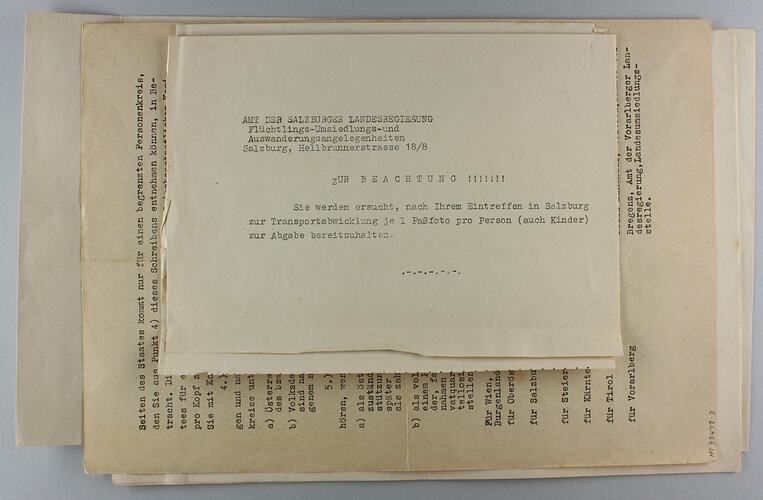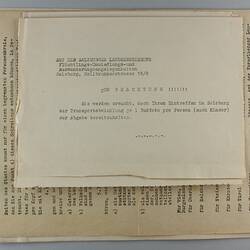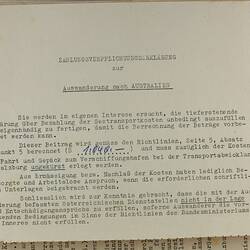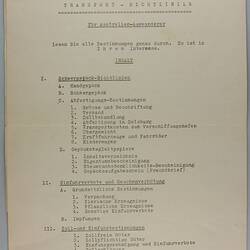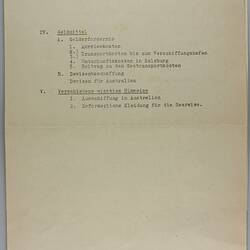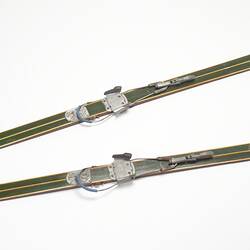Summary
Eight single and double-sided typed sheets including fact sheets and correspondence issued to Dorothea Huber [nee Freitag and later Dunzinger] in preparation for her migrant voyage from Austria to Melbourne onboard the Cogedar Line ship 'Flaminia' in November 1959. The material includes four stapled sheets outlining Transport Guidelines for Emmigrants to Australia ['Transport-Richtlinien'] which relate to heavy luggage, import and health regulations, customs and imports, money and other important issues. There is also a fact sheet on Preparing for Emigration ['Merkblatt fur die Auswanderungsvorbereitung'], payment obligations ['Zahlungsverpflichtungserklarung'], a half page sheet relating to transportation and a sheet dated 19 August 1959 addressed to Dorothea Huber referring amongst other things to her emigration registration, 3 September 1959.
Born in 1929 near Graz, Austria, Dorothea Dunzinger [formerly Huber and nee Freitag] was a proficient recreational skier and part of a volunteer rescue team in Switzerland. She lived and worked primarily as a mill weaver and seamstress in England, Switzerland and Austria before migrating to Australia from Austria on 30 November 1959, arriving on the Cogedar Line ship 'Flaminia' on 31 December. She settled in Melbourne and married fellow Austrian Johann Dunzinger whom she met at Broadmeadows migrant hostel. They had a daughter Caroline and lived in various Melbourne suburbs boarding and renting before building a home in Kalorama. The couple divorced in1978. Dorothea worked hard all her life, owning a boutique clothing shop in Camberwell at one stage but primarily as a textile outworker and factory worker trying to make ends meet. She died in 2001.
Physical Description
Set of 4 single sheets and 1 stapled set of sheets of typed cream paper. All text in German.
Significance
The Dunzinger Austrian Migrant Collection has evolved to become a rich group of objects which tell a particular story of an Austrian woman's post-war migration experiences, as well as broader contextual narratives relating to the variety of selection and management processes in place in Europe after World War II. These include references to Australian-specific organisations involved in migration management such as the Australian Migration Mission. Items explore the enthusiastic promotional activities of the Australian Government to encourage migration from the UK and Europe in order to populate Australia and build a workforce. Artefacts also relate to a significant Italian migrant ship of the period, the Cogedar Line 'Flotto Lauro'.
There is a also symbolic poignancy about the skis and the small sewing machine Dorothea Dunzinger brought with her from Austria: the skis representing precious mementoes from home and hopes and expectations for the leisure activity they might bring in Australia; the sewing machine a pragmatic object which came to dominate Dorothea's actual settled life of hard work both in the home and as an outworker with no leisure time at all.
More Information
-
Collecting Areas
-
Acquisition Information
Donation from Ms Caroline Dunzinger, 07 Nov 2012
-
Issued To
-
Inscriptions
Title stapled set: 'Transport-Richtlinien'. Title 2 sided sheet: 'Merkblatt fur die Auswanderungsvorbereitung'. Title half sheet: 'Zahlungsverpflichtungserklarung'. Single sheet: '19.8.1959/Dorothea Huber/3 Sep 1959/ Bregenz, Montfortstr. 12/11/65' Extensive text.
-
Classification
Migration, Processing - planning & departure, Rules & regulations
-
Category
-
Discipline
-
Type of item
-
Overall Dimensions
200 mm (Width), 344 mm (Height)
-
Overall Dimensions
210 (Width), 295 (Height)
-
Overall Dimensions
210 mm (Width), 150 mm (Height)
-
Overall Dimensions
210 mm (Width), 163 mm (Height)
Dimensions for 4 single sheets and 1 stapled set of sheets.
-
Keywords
Austrian Immigration, Post War Migration, Migration & Settlement, Migration Schemes, Immigration Selection, Immigration
